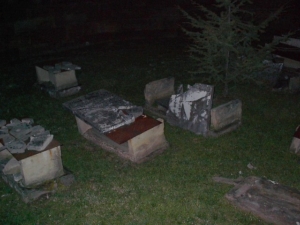The OES visited Stonewall Cemetery on March 16, 2003. Also known as the Wilson Family Cemetery and the President’s Burying Ground, this unique cemetery was founded in 1817 by Nathaniel Wilson, an early pioneer to Fairfield County. Nathaniel and his son Gustin built a magnificent 12-sided, 8-foot-tall stone wall surrounding their family plot between 1838 and 1839. A cedar of Lebanon tree, imported from Palestine, was planted inside the cemetery as Nathaniel wanted a touch of the Holy Land in his cemetery. The tree eventually died but was replaced by another cedar of Lebanon. The stone wall surrounding the family graveyard is the only structure of its kind in the world, constructed of Blackhand sandstone quarried from nearby Allen’s Knob. Every angle was hand-cut so the stones would fit together perfectly without the use of mortar. The arch directly above the entrance is aligned with the north star, Polaris. Nathaniel Wilson III willed the cemetery to President James Monroe and all future Presidents on April 22, 1817. For many years, Fairfield County officials would notify each new President that he was the cemetery’s trustee. Only one, Franklin D. Roosevelt, ever acknowledged the notification. No President has been buried or has even visited the cemetery. Of course with such a unique cemetery, it is almost guaranteed to have a legend. It is said that if one climbs on top of the wall and walks around it thirteen times, the spirits within will suck them into the circle. Or, perhaps, you just get dizzy from walking in a circle thirteen times and fall in.
Location Information: Inactive Cemetery [Safe]
Stonewall Cemetery is located on the west side of Stonewall Cemetery Road in Lancaster; Fairfield County.
Photographs
The engraving above the gate stated the following:
THIS WALL
which encloses the family burying ground of
NATHANIEL WILSON (one of the early Pioneers of
the West) who emigrated from Cumberland County Pa and settled near this place
AD 1798, when all around was one continued and uninhabited
wilderness, was commenced by him AD 1838 & finished in the following year
by his son Gustin, the former having suddenly died on May 12, 1839.















